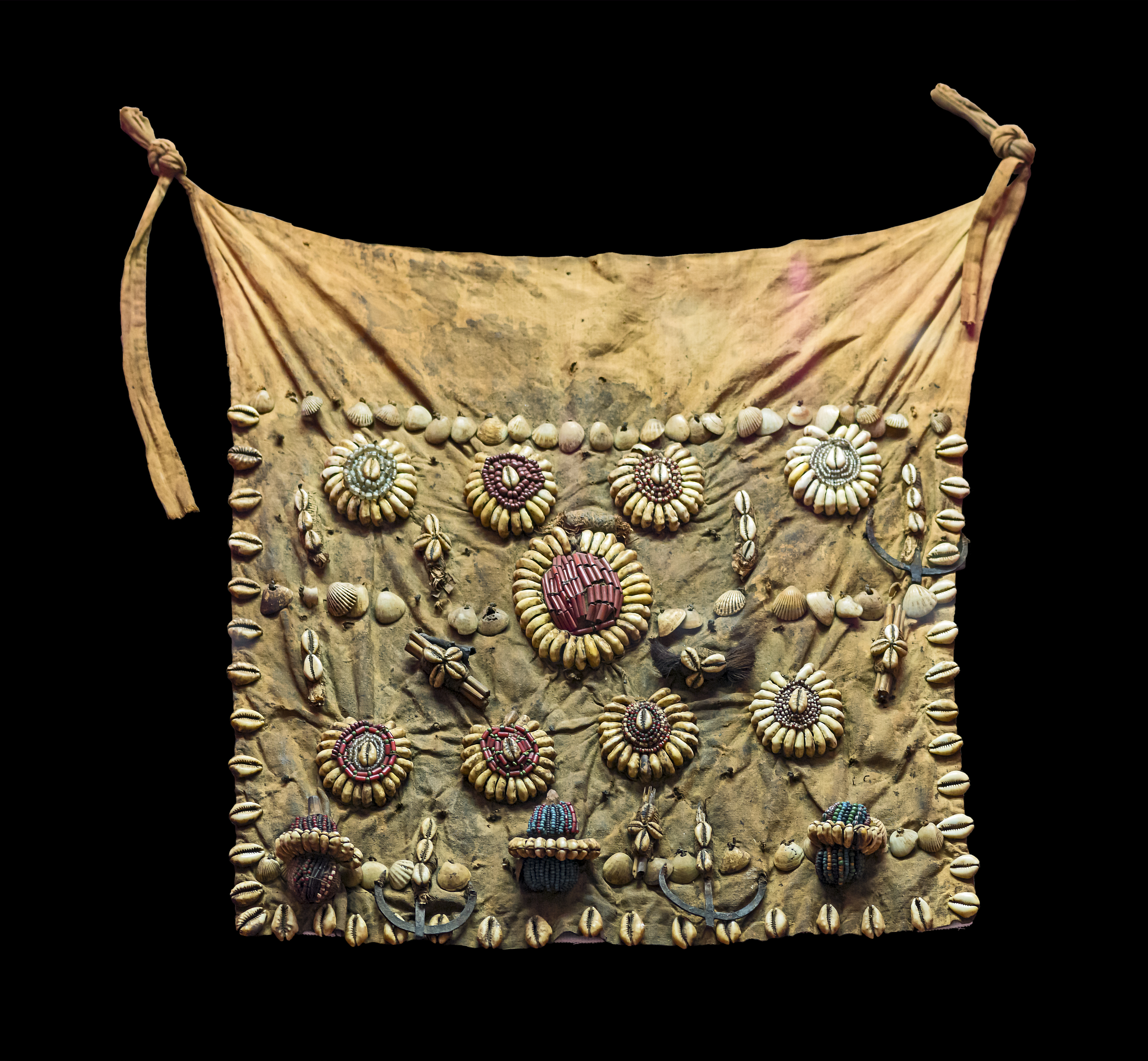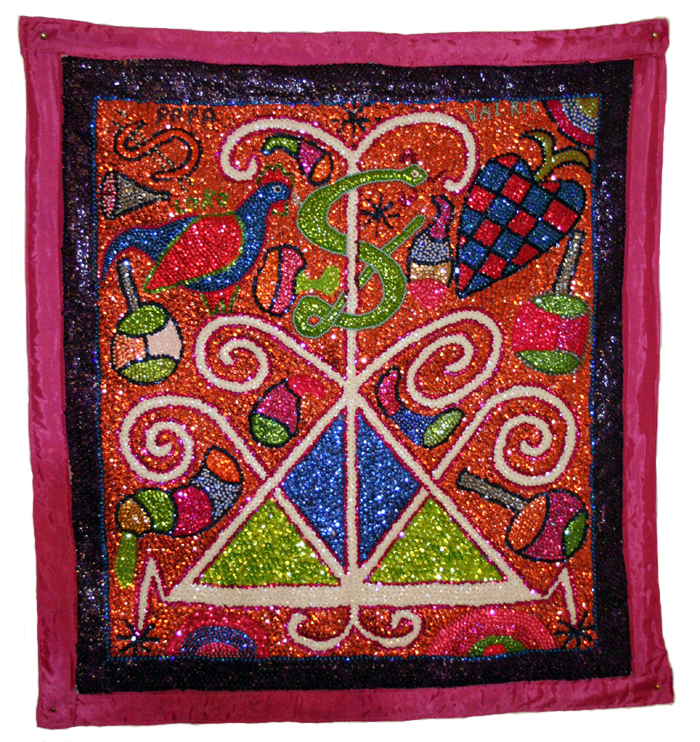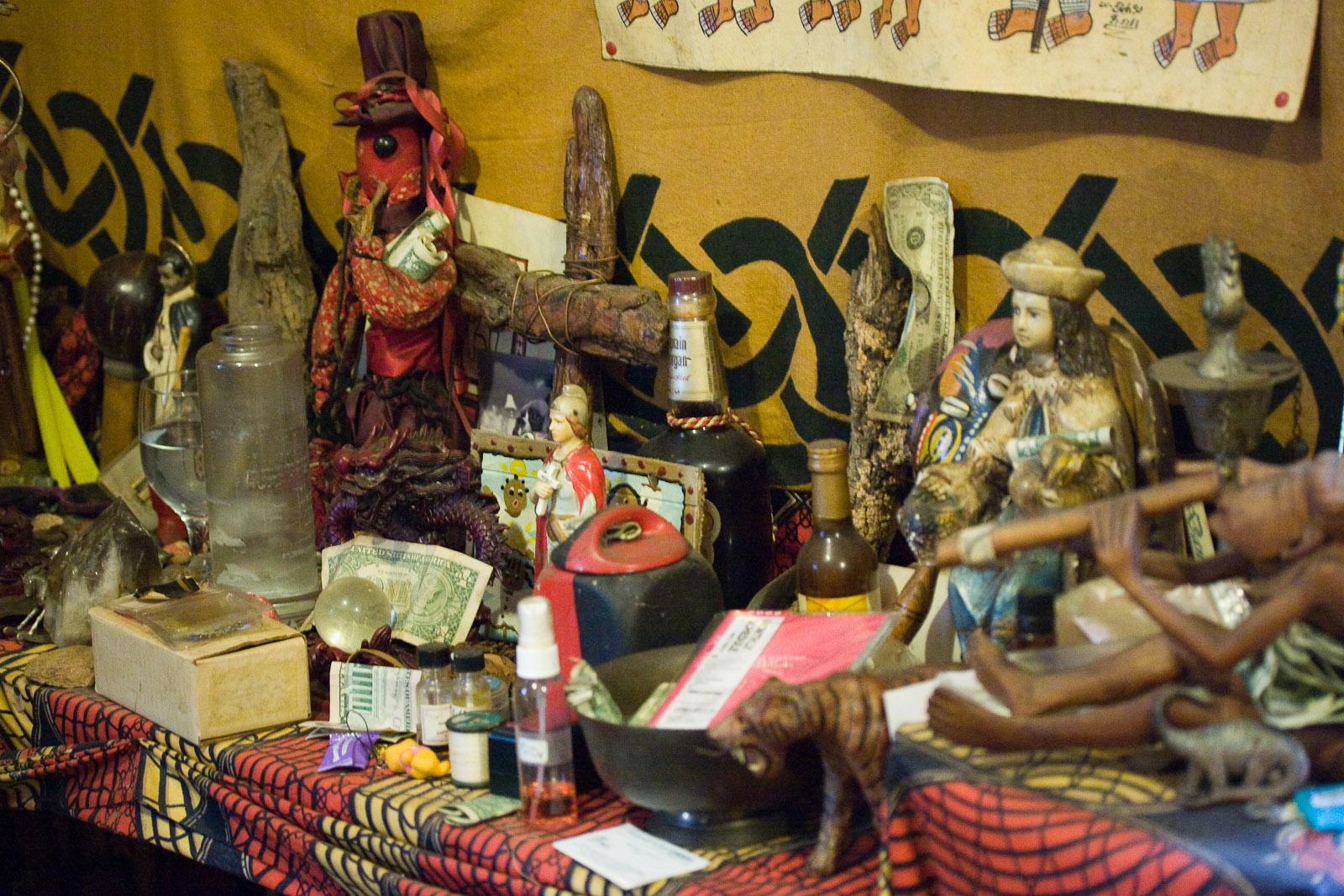|
Cuban Vodú
Cuban Vodú is a religion indigenous to Cuba. It is a religion formed from the blending of Fon and Ewe beliefs and Dahomey religion which came to form Haitian Vodou. Loa are worshiped by the religion's practitioners. Cuban Vodú is noteworthy for its popularity in the Oriente Province of Cuba and a lack of academic study of the religion. Even though much of the practices come from Haitian immigrants bringing Haitian Vodou to Cuba the Cuban practices subsequently evolved and came to differ in some ways. For instance: feats of strength are more common in ceremonies and dance movements differ. Cuban Vodú is composed of three divisions: the ''Indigenous American Division'', whose spirits are of American origin (usually refers to Taíno spirits); the ''African Division'', whose spirits are of African origin (usually Fon and Ewe spirits); and the ''European Division'', whose spirits are of European origin (usually Spanish spirits). See also * Candomblé Jejé * Dominican Vudu * ... [...More Info...] [...Related Items...] OR: [Wikipedia] [Google] [Baidu] |
Arará
The Arará people form an Afro-Cuban ethnoreligious group descended from the Dahomey kingdom of West Africa, and retaining an identity, religion, and culture separate from those of other Afro-Cuban peoples. Although, historically, the Arará people have been staunch defenders of their separate heritage and religion, this distinct identity - while it still persists - has, over time, become increasingly blurred and harder to maintain. History Origins The Arará were originally enslaved as prisoners-of-war in the invasions of Dahomey by the Oyo Empire. Years after enslavement and transport to Cuba, Yoruba slaves descendant from the Oyo Empire began to arrive in Cuba. Due to the pre-existing tensions in West Africa these two groups remained socially distant and developed separate cultures and identities. Despite close similarities in their religious practices both groups retained separate priesthoods. It was not until the early 1900s that Arará and Yoruba Cubans became sufficiently ... [...More Info...] [...Related Items...] OR: [Wikipedia] [Google] [Baidu] |
Fon People
The Fon people, also called Fon nu, Agadja or Dahomey, are a Gbe ethnic group.Fon people Encyclopædia Britannica, undated, 1.7 million population, Retrieved June 29, 2019 They are the largest ethnic group in found particularly in its south region; they are also found in southwest and . Their total population is estimated to be about 3,500,000 people, and they speak the Fon language [...More Info...] [...Related Items...] OR: [Wikipedia] [Google] [Baidu] |
Ewe People
The Ewe people (; ee, Eʋeawó, lit. "Ewe people"; or ''Mono Kple Volta Tɔ́sisiwo Dome'', lit. "Ewe nation","Eʋenyigba" Eweland;) are a Gbe-speaking ethnic group. The largest population of Ewe people is in Ghana (6.0 million), and the second largest population is in Togo (3.1 million). They speak the Ewe language ( ee, Eʋegbe) which belongs to the Gbe family of languages. They are related to other speakers of Gbe languages such as the Fon people, Fon, Gen language, Gen, Phla Phera, Gun, Maxi, and the Aja people of Togo, Benin and southwestern Nigeria. Demographics Ewe people are located primarily in the coastal regions of West Africa: in the region south and east of the Volta River to around the Mono River at the border of Togo and Benin; and in the southwestern part of Nigeria (close to the Atlantic Ocean, stretching from the Nigeria and Benin border to Epe). They are primarily found in the Volta Region in southeastern Ghana, southern Togo, in the southwestern part ... [...More Info...] [...Related Items...] OR: [Wikipedia] [Google] [Baidu] |
Dahomey Religion
The Dahomean religion was practiced by the Fon people of the Dahomey Kingdom. The kingdom existed until 1898 in what is now the country of Benin. People taken from Dahomey to the Caribbean used elements of the religion to form Vodou and other religions of the Afro-Caribbean diaspora. ''Mawu'' and ''Lisa'' Lisa (male) and Mawu (female), married twin siblings of Nana Buluku, are the creator spirits, occasionally combined as Mawu-Lisa, an androgynous spirit. Mawu-Lisa created the world and made it orderly, then made plants, animals, and humans; the entire process took four days. *The first day, Mawu-Lisa created the world and humanity; *The second day the earth was made suitable for human life; *On the third day, humans were given intellect, language, and the senses; *Finally, on the fourth day, mankind received the gift of technology. Offspring-spirits of ''Mawu'' and ''Lisa'' *Gbadu *Da and Gu * Dan Other spirits * Agé * Avrikiti * Ayaba * Egberun * Fa * Gleti * Gu * Le ... [...More Info...] [...Related Items...] OR: [Wikipedia] [Google] [Baidu] |
Haitian Vodou
Haitian Vodou is an African diasporic religion that developed in Haiti between the 16th and 19th centuries. It arose through a process of syncretism between several traditional religions of West and Central Africa and Roman Catholicism. There is no central authority in control of the religion and much diversity exists among practitioners, who are known as Vodouists, Vodouisants, or Serviteurs. Vodou revolves around spirits known as ''lwa.'' Typically deriving their names and attributes from traditional West and Central African divinities, they are equated with Roman Catholic saints. The lwa divide up into different groups, the ''nanchon'' ("nations"), most notably the Rada and the Petwo. Various myths and stories are told about these lwa, which are regarded as subservient to a transcendent creator deity, Bondye. This theology has been labelled both monotheistic and polytheistic. An initiatory tradition, Vodouists usually meet to venerate the lwa in an ''ounfò'' (temple), run ... [...More Info...] [...Related Items...] OR: [Wikipedia] [Google] [Baidu] |
Oriente Province
Oriente (, "East") was the easternmost province of Cuba until 1976. The term "Oriente" is still used to refer to the eastern part of the country, which currently is divided into five different provinces. Fidel and Raúl Castro were born in a small town in this province ( Birán). The origins of Oriente lie in the 1607 division of Cuba into a western and eastern administration. The eastern part was governed from Santiago de Cuba and it was subordinate to the national government in Havana. In 1807, Cuba was divided into three ''departamentos'': Occidental, Central and Oriental. This arrangement lasted until 1851, when the central department was merged back into the West. In 1878, Cuba was divided into six provinces. Oriente remained intact but was officially renamed to Santiago de Cuba Province until the name was reverted to Oriente in 1905. This lasted until 1976, when the province was split into five different provinces: Las Tunas Province, Granma Province, Holguín Provin ... [...More Info...] [...Related Items...] OR: [Wikipedia] [Google] [Baidu] |
Taíno People
The Taíno were a historic Indigenous peoples of the Caribbean, indigenous people of the Caribbean whose culture has been continued today by Taíno descendant communities and Taíno revivalist communities. At the time of European contact in the late 15th century, they were the principal inhabitants of most of what is now Cuba, Dominican Republic, Jamaica, Haiti, Puerto Rico, the Bahamas, and the northern Lesser Antilles. The Lucayan people, Lucayan branch of the Taíno were the first New World peoples encountered by Christopher Columbus, in the Lucayan Archipelago, Bahama Archipelago on October 12, 1492. The Taíno spoke a dialect of the Arawakan languages, Arawakan language group. They lived in agricultural societies ruled by Cacique, caciques with fixed settlements and a matrilineal system of kinship and inheritance. Taíno religion centered on the worship of zemis. Some anthropologists and historians have claimed that the Taíno were exterminated centuries ago or they gradual ... [...More Info...] [...Related Items...] OR: [Wikipedia] [Google] [Baidu] |
Zemi
A zemi or cemi was a deity or ancestral spirit, and a sculptural object housing the spirit, among the Taíno people of the Caribbean.Bercht et al, 23 They were also created by indigenous South Americans.Bercht et al, 24 Theology Taíno religion, as recorded by late 15th and 16th century Spaniards, centered on a supreme creator god and a fertility goddess. The creator god is Yúcahu Maórocoti and he governs the growth of the staple food, the cassava. The goddess is Attabeira, who governs water, rivers, and seas. Lesser deities govern natural forces and are also zemis.Bercht et al, 23 Boinayel, the Rain Giver, is one such zemi, whose magical tears become rainfall."Deity Figure (Zemi) Dominican Republic; Taino (1979.206.380)" In Heilbrunn Timeline of Art History. New York: The M ... [...More Info...] [...Related Items...] OR: [Wikipedia] [Google] [Baidu] |
Spaniards
Spaniards, or Spanish people, are a Romance ethnic group native to Spain. Within Spain, there are a number of national and regional ethnic identities that reflect the country's complex history, including a number of different languages, both indigenous and local linguistic descendants of the Roman-imposed Latin language, of which Spanish is the largest and the only one that is official throughout the whole country. Commonly spoken regional languages include, most notably, the sole surviving indigenous language of Iberia, Basque, as well as other Latin-descended Romance languages like Spanish itself, Catalan and Galician. Many populations outside Spain have ancestors who emigrated from Spain and share elements of a Hispanic culture. The most notable of these comprise Hispanic America in the Western Hemisphere. The Roman Republic conquered Iberia during the 2nd and 1st centuries BC. Hispania, the name given to Iberia by the Romans as a province of their Empire, became highly accu ... [...More Info...] [...Related Items...] OR: [Wikipedia] [Google] [Baidu] |
Candomblé Jejé
Candomblé Jejé, also known as Brazilian Vodum, is one of the major branches (''nations'') of Candomblé. It developed in the Portuguese Empire among Fon and Ewe slaves. Vodums Jejé spirits are called ''Voduns'' (sing. ''Vodum''). According to tradition, they were introduced into the Kingdom of Dahomey from nearby lands by its founder King Adja-Tado, on the advice of a ''bokono'' (seer). Their cult was reorganized and uniformized by King Agajah in the 18th century. Jejé Vodums are sometimes cultuated in houses of other nations by different names. For instance, the Vodum Dan or Bessen is called Oxumarê in Candomblé Ketu. Conversely, the Ketu Orixás may be cultuated in Jejé houses, but retain their names. Voduns are organized into families: Bibliography * See also *Candomblé *Tambor de Mina (mixture of Dahomean religion, Yoruba Religion, Indigenous American, and European traditions, in Maranhão, Brazil Brazil ( pt, Brasil; ), officially the Federative ... [...More Info...] [...Related Items...] OR: [Wikipedia] [Google] [Baidu] |
Dominican Vudu
Dominican may refer to: * Someone or something from or related to the Dominican Republic ( , stress on the "mi"), on the island of Hispaniola in the Greater Antilles, in the Caribbean ** People of the Dominican Republic ** Demographics of the Dominican Republic ** Culture of the Dominican Republic * Someone or something from or related to the Commonwealth of Dominica ( , stress on the "ni"), an island nation in the Lesser Antilles, in the Caribbean ** People of Dominica ** Demographics of Dominica ** Culture of Dominica * Dominican Order, a Catholic religious order Schools * Dominican College (other), numerous colleges throughout the world * Dominican School of Philosophy and Theology, Berkeley, California, United States * Dominican University (Illinois), River Forest, Illinois, United States * Dominican University of California, San Rafael, California, United States * Dominican University New York Dominican University New York is a private college in Orangeburg, Ne ... [...More Info...] [...Related Items...] OR: [Wikipedia] [Google] [Baidu] |
Louisiana Voodoo
Louisiana Voodoo (french: Vaudou louisianais, es, Vudú de Luisiana), also known as New Orleans Voodoo, is an African diasporic religion which originated in Louisiana, now in the southern United States. It arose through a process of syncretism between the traditional religions of West Africa, the Roman Catholic form of Christianity, and Haitian Vodou. No central authority is in control of Louisiana Voodoo, which is organized through autonomous groups. Historical records reveal the names of various deities who were worshiped in Voodoo, prominent among them were Blanc Dani, the Grand Zombi, and Papa Lébat. These were venerated at altars, where sacrifices were made to them. Spirits of the dead also played a prominent role in historical Voodoo, with some contemporary practitioners regarding the religion as a form of ancestor worship. Historical accounts suggest that in the 19th century, the saints played a prominent role, although amid the 20th-century revival, the veneration ... [...More Info...] [...Related Items...] OR: [Wikipedia] [Google] [Baidu] |



_MET_DP295635.jpg)
